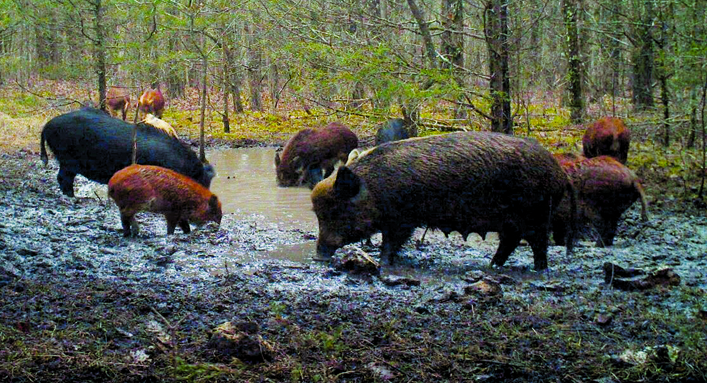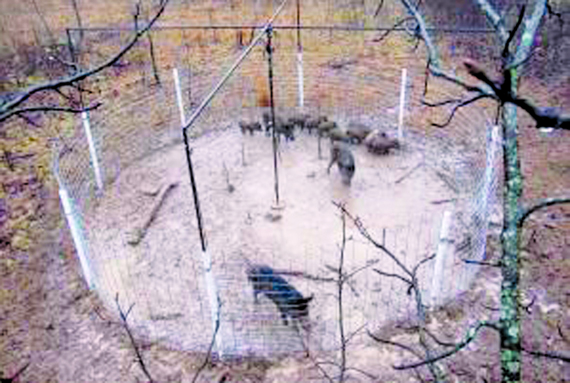Coincidentally, I conducted this interview about the feral hog problem last Thursday with Alan Leary, Certified Wildlife Biologist, Interim Wildlife Management Chief – Ozark Unit, Missouri Department of Conservation. Then on Friday, I received a full article on the topic from the MDC. Here is what Mr. Leary told the Sun:
Feral hogs first started becoming a problem in Missouri in the mid 1990’s.

SOW RETURNS TO HER WALLOW – Feral hogs, just like domestic ones, love to cool off by creating wallows. Unlike those created by domestic hogs, the wallow is not always where the landowner approves.
The Missouri Feral Hog Partnership has developed a strategic plan that when fully implemented we believe will achieve the goal of total elimination of feral hogs from the State of Missouri.
They don’t want to be around people. When they feel pressure, they will adjust their behavior and start being more nocturnal and move to a different area where there is less human disturbance. They don’t want to be bothered and they don’t want to be around people.
No estimate of number in Missouri.
Largest population is in SE Missouri.
Working on elimination in Schell Osage Area.
The populations are scattered.
People have intentionally released them as evidenced by having hogs in one area then no hogs for maybe 50 miles. They didn’t walk that far and decide this is where they wanted to stop. There aren’t very many people out there that would do this but there are some.
Q. Why would someone release them?
To create hunting opportunities in new areas.
Q. Dollar amount of damage?
Not for Missouri. About 10 years ago there was a study done that estimated that they are doing $1.5 billion in damage nationally. And that’s a 10-year-old study so no doubt that amount would be quite a bit higher today.
I know farmers in Missouri contact us very frustrated that the hogs continue to destroy crops they have planted.
Q. Is trapping your best method of eliminated feral hogs?
Yes, that is the most effective method because you remove the entire sounder at once.
Q. And I understand you don’t want people to hunt them.
It scatters them and it’s an incentive for people to intentionally release them. If you get into a group of 20 hogs when you are hunting, more than likely you will only get one or two from that group. With the reproductive rate of feral hogs, you don’t make any progress that way. The other 18 quickly repopulate the area.
With a trap, we get an entire group called a sounder. In fact, one of the guys actually got 62 hogs in one drop trap in one night. That’s very effective.
We leave it up to the landowner what happens to them if they are on private property.
Q. I wonder if they are any good.
I know they carry a lot of diseases. Some of those diseases can be transmitted to humans, livestock and pets.
We responded to one landowner who had just planted corn. The hogs went right down the row and it just looked like the planter had done it. But the hogs went right down the row and removed every seed he had just planted.
The USDA has full time hog trappers here in Missouri.
Q. I’ve heard you hunt them from helicopters.
 FERAL HOGS IN TRAP – Feral hogs root and wallow in mud wherever they are, removing vegetation. This photo of hogs in a trap demonstrates that concept. One sounder, or group, of hogs is capable of damaging 10-25 acres in a single night.
FERAL HOGS IN TRAP – Feral hogs root and wallow in mud wherever they are, removing vegetation. This photo of hogs in a trap demonstrates that concept. One sounder, or group, of hogs is capable of damaging 10-25 acres in a single night.
We don’t hunt them, we are eliminating an extremely destructive invasive species. The USDA has a helicopter from out of state that comes in and does some aerial gunning. They get into some areas that are hard to access from the ground. They are also trying to get the entire group.
The Conservation Department and our partners around the state in calendar year 2018, we removed over 9,300 hogs. We look at occupancy rate. That’s a good number of hogs that aren’t tearing up our crops and destroying our natural resources.
Q. And this all started because people were releasing them to hunt?
I don’t know how they initially got to Missouri. I know that new populations have been started because people released them. Some of the initial ones were likely accidental escapes of domestic hogs.
The message that MDC and our partners are giving people in Missouri is: we want you to report feral hogs, not shoot them. We will come out and assist them in trapping the hogs and try to remove the entire group.
We have passed a regulation that prohibits people from taking feral hogs on land that is owned, leased or managed by the Department of Conservation.
It’s going to take a dedicated effort to eliminate feral hogs and it’s going to take cooperation from a lot of partners, individuals, groups, agencies and organizations all trying to reach the same goal of total elimination, but I think we can still do it in Missouri.
Q. Partners?
U. S. Forest Service, Corps of Engineers, Ft. Leonard Wood, U.S. Fish and Wildlife Service, National Park Service, the Department of Natural Resources, Missouri Department of Agriculture, Missouri Department of Health and Senior Services, and there’s a long list of non-governmental agencies that we partner with as well. I don’t want to start listing them and leave some off. There are some conservation groups and some agricultural groups that are partnering with us and obviously hundreds of private landowners. The majority of the land in Missouri is private property.
Q. Where all are the hogs located?
Further south like Texas has large numbers of hogs. They kill many thousands every year down there. Louisiana has it bad. Georgia has a large population. Alabama has a large population. Florida has a large population. The Southeast seems to be where they are the worst. I believe they are now found in 38 states. They even have them in Hawaii. They didn’t swim out there.
Q. I wonder if the winters hold down the populations as you go further north.
Michigan has them. They have them in several Canadian provinces, but not as many. I don’t know if they struggle with the winters or have been more recently introduced.



Facebook Comments